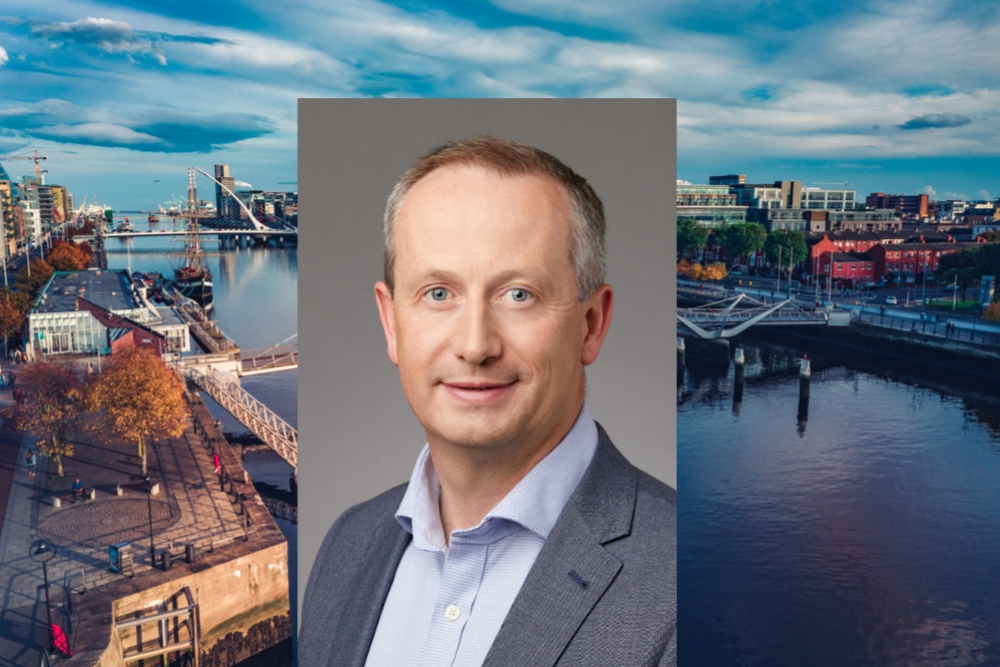Vodafone Ireland’s HR director James Magill talks to John Kennedy about navigating the mobile network giant’s 1,200 Irish workforce through the pandemic and into the blended future of work via its new 60/40 hybrid model.
A year ago, this week, many thousands of office workers from across Ireland left their buildings, not realising it would be the last time for a very long time. What many believed would be just a few weeks blossomed into a full year of working from home. And most of us are still at home and will be for the foreseeable future.
This unexpected year brought with it many challenges from isolation and mental health to juggling child-minding and home-schooling responsibilities. It accelerated digital transformation and remote working and proved just how intrinsic and potent broadband can be as an economic force multiplier and a social life saver.
“People that have clarity on their goals are also the same people who say they feel better, they feel more supported, and therefore they feel more effective”
For Vodafone’s head of HR in Ireland James Magill the response required empathy and a lot of thought about what the future of work would look like.
The company came to realise that there is no ‘one size fits all’ solution to the future of work and has listened carefully to what workers want. The result is a new 60:40 hybrid model that will see all of its workers spend 60pc of their time working remotely and 40pc working in teams at the office.
The key word is ‘balance’
“We already had a strong platform of mobile working enablement that we embraced internally and as an organisation we had a strong history of flexible working pre-pandemic,” says Magill. “Our office spaces were open plan and designed for collaboration. We had the environment set, the trust was set and people managers were used to managing people with a high degree of flexibility.
“But what was different was they were suddenly facing into an accelerated version of that.”
Prior to lockdown the company had all staff work at home to test their VPNs (virtual private networks) to iron out teething problems.
While that all sounds very organised, Magill said that the real challenge wasn’t technological, it was human.
“The challenge was to put in place structures that everybody across the organisation could benefit from and feel supported by.”
Magill said that it was evident as time wore on that the initial fighting spirit across Ireland’s workforce was giving way to strain as the various phases of the lockdown took their toll. “We have always had a really strong track record around supporting the wellbeing of our people, including not only physical wellness but also focusing on mental wellness.
“Your people have to believe that you care about them. That sounds like a simple thing, but what messages were you pushing to your people from the beginning of this pandemic to show that they were the number one priority? Our messaging was about safety but also keeping you in balance.”
A longstanding partnership with Spectrum Health/Laya Healthcare resulted in the creation of a digital platform called Evolve. “It meant that when the pandemic came, I was able to work with Spectrum to build out content and they provided us with incredible support, with content ranging from managing work schedules to mental wellness and health through to workshops on parenting in a crisis. The objective was to create a sense of safety and destigmatise the mental wellness conversation within the organisation.”
Effectiveness over productivity
In terms of productivity, Magill said that the key was to create work life balance but also ensure that people don’t burn out.
“It’s whatever it takes to get into the right frame of mind, because that’s work”
“A core focus was on the role of the people leader. You can have all the workplace policies in the world, but if people ignore them they won’t come to life in a meaningful way. We introduced policies such as a ‘right to disconnect’ policy and making sure people were managing their work schedule, being able to switch off and have balance. We rolled that policy out over the summer and reinforced it in December.
“We worked with our people managers to discourage meetings outside of core hours, ensure people were having proper lunch breaks and weren’t sending emails after hours.
“I think one of the streams of work that we are most proud of is the work we have done with our people leaders because they are the people on the ground best placed to assess if people are struggling and that they have the support they need. It was about bringing those people leaders together to help learn, support and understand.”
60/40: Rethinking the purpose of the office
The pandemic caused remote working to go from a fringe activity to rapidly become an established way of working, and many office workers have no intention of going back to the way things were in terms of long, non-productive commutes and meetings about meetings.
“Reducing the urban-rural divide is an opportunity to generate jobs and boost the economy in rural communities”
With people looking to the eventual return to normal involving a combination of remote and in-office working, the lexicon is also changing with blended working becoming the new hybrid working.
Vodafone’s particular model of the blended future is 60/40.
From talking to Magill, flexible working was already an established practice at Vodafone but a fundamental rethink of why people went into the office was occurring.
“What is the purpose of the office? Where do I need to be to do my job? Why do I go into the office? Should I only go into the office for team meeting for planning and collaboration? Are some tasks accomplished better face-to-face?
“So the nature of the office has definitely changed. Now if I could really define what the future of work will look like I’d be a very rich man, but I’d like to think we have identified some of the principles.
“Some things are done better and more efficiently remotely. Other things work better or can be accelerated when we’re together and with each other. Collaboration is accelerated. Innovation is accelerated by being together, in peer-to-peer learning or bumping into each other.”
So how do you create a sense of inclusion, belonging and connectedness in the blended/hybrid model?
“We started to talk about it last summer and we have crystalised it into our 60/40 model. About 30pc to 40pc of your time will be in the office to collaborate but 60pc of your time is out of the office. And it’s not about whether you are in the office or home working. It’s much more nuanced than that.
“Perhaps you are more productive away from the office, perhaps you want to go and work from a table in a café because you might need the ambient background noise. Or maybe you need to take a walk around your nearest museum or art gallery to feel inspired. Or take the dog for a walk. It’s whatever it takes to get into the right frame of mind, because that’s work.”
A wider skills and talent pool
Magill says the pandemic has redefined many aspectd of the HR function, especially in terms of access to skills and talent.
“How does the hybrid model allow for the erosion of geographic barriers to really access talent regardless of location? This is super exciting and it’s an opportunity for all businesses. Reducing the urban-rural divide is an opportunity to generate jobs and boost the economy in rural communities. There are opportunities around remotely hiring people and there are many jobs people will be able to do entirely remotely. I think this is exciting not only for Ireland but for Europe in terms of really eroding geographic barriers.”
In conclusion, the biggest lesson of the past year, Magill believes, boils down to trust and empowerment. That it’s not just about how organisations have had to get comfortable with people not being in the office, and simply trusting them to get on with their jobs.
“And guess what? Productivity was not negatively impacted. But it reveals a lot about an organisation if they start with productivity. What we start with is the idea of trust. It’s about trusting people and enabling them. It’s about investing in our people managers so they can remove the barriers for staff.
“We’ve learnt that it’s not just about measuring productivity alone. It’s also how it all joins up with wellbeing and balance. We learnt that people that have clarity on their goals are also the same people who say they feel better, they feel more supported, and therefore they feel more effective.”
By John Kennedy (john.kennedy3@boi.com)
Published: 16 March 2021






